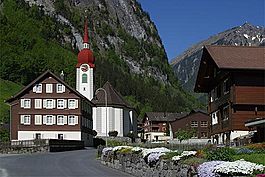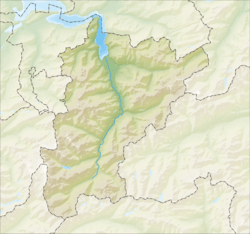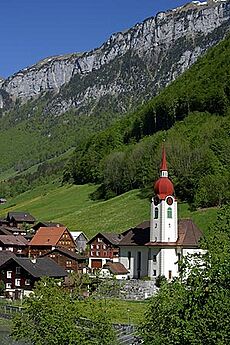Isenthal facts for kids
Quick facts for kids
Isenthal
|
||
|---|---|---|
 |
||
|
||
| Country | Switzerland | |
| Canton | Uri | |
| District | n.a. | |
| Area | ||
| • Total | 60.97 km2 (23.54 sq mi) | |
| Elevation | 771 m (2,530 ft) | |
| Population
(Dec 2020 )
|
||
| • Total | 476 | |
| • Density | 7.807/km2 (20.220/sq mi) | |
| Postal code |
6461
|
|
| Surrounded by | Attinghausen, Bauen, Beckenried (NW), Emmetten (NW), Engelberg (OW), Flüelen, Seedorf, Seelisberg, Wolfenschiessen (NW) | |
Isenthal is a municipality in the canton of Uri in Switzerland.
History
Isenthal is first mentioned in 1280 as Yseltal.
Geography
Isenthal has an area, (as of the 2004/09 survey) of 60.97 km2 (23.54 sq mi). Of this area, about 28.0% is used for agricultural purposes, while 27.1% is forested. Of the rest of the land, 0.8% is settled (buildings or roads) and 44.0% is unproductive land. Over the past two decades (1979/85-2004/09) the amount of land that is settled has increased by 17 ha (42 acres) and the agricultural land has decreased by 32 ha (79 acres).
In the 1993 land survey[update], 21.4% of the total land area was heavily forested, while 1.4% is covered in small trees and shrubbery. Of the agricultural land, 5.7% is used for orchards or vine crops and 22.2% is used for alpine pastures. Of the settled areas, 0.3% is covered with buildings, and 0.2% is transportation infrastructure. Of the unproductive areas, 0.9% is unproductive flowing water (rivers), 35.6% is too rocky for vegetation, and 8.8% is other unproductive land.
The municipality is located at the intersection of the Chlital and the Grosstal. It consists of the village of Isenthal and widely scattered small settlements.
Demographics
Isenthal has a population (as of December 2020[update]) of 476. As of 2013[update], 1.0% of the population are resident foreign nationals. Over the last 3 years (2010-2013) the population has changed at a rate of -0.95%. The birth rate in the municipality, in 2013, was 3.8 while the death rate was 5.7 per thousand residents.
As of 2013[update], children and teenagers (0–19 years old) make up 25.6% of the population, while adults (20–64 years old) are 58.4% and seniors (over 64 years old) make up 16.0%.
In 2013 there were 168 private households in Isenthal. Of the 172 inhabited buildings in the municipality, in 2000, about 47.7% were single family homes and 16.9% were multiple family buildings. Additionally, about 44.8% of the buildings were built before 1919, while 14.0% were built between 1991 and 2000. In 2012 the rate of construction of new housing units per 1000 residents was 1.89. The vacancy rate for the municipality, in 2014[update], was 1.61%.
Most of the population (as of 2000[update]) speaks German (99.3%), with Polish being second most common (0.4%) and French being third (0.2%). As of 2007[update] the gender distribution of the population was 52.4% male and 47.6% female.
The historical population is given in the following table:
| Year | Population |
|---|---|
| 1698 | c. 150 |
| 1743 | 176 |
| 1799 | 360 |
| 1850 | 502 |
| 1900 | 595 |
| 1950 | 550 |
| 1970 | 570 |
| 1980 | 535 |
| 1990 | 505 |
| 2000 | 539 |
| 2005 | 538 |
| 2007 | 536 |
Economy
As of 2012[update], there were a total of 215 people employed in the municipality. Of these, a total of 129 people worked in 47 businesses in the primary economic sector. The secondary sector employed 26 workers in 13 separate businesses. Finally, the tertiary sector provided 60 jobs in 18 businesses. In 2013 a total of 1.9% of the population received social assistance.
Education
In Isenthal about 60.5% of the population (between age 25–64) have completed either non-mandatory upper secondary education or additional higher education (either university or a Fachhochschule).
Weather
Isenthal has an average of 150.2 days of rain per year and on average receives 1,562 mm (61.5 in) of precipitation. The wettest month is July during which time Isenthal receives an average of 193 mm (7.6 in) of precipitation. During this month there is precipitation for an average of 14.4 days. The month with the most days of precipitation is June, with an average of 15.5, but with only 182 mm (7.2 in) of precipitation. The driest month of the year is February with an average of 95 mm (3.7 in) of precipitation over 14.4 days.
See also
 In Spanish: Isenthal para niños
In Spanish: Isenthal para niños






